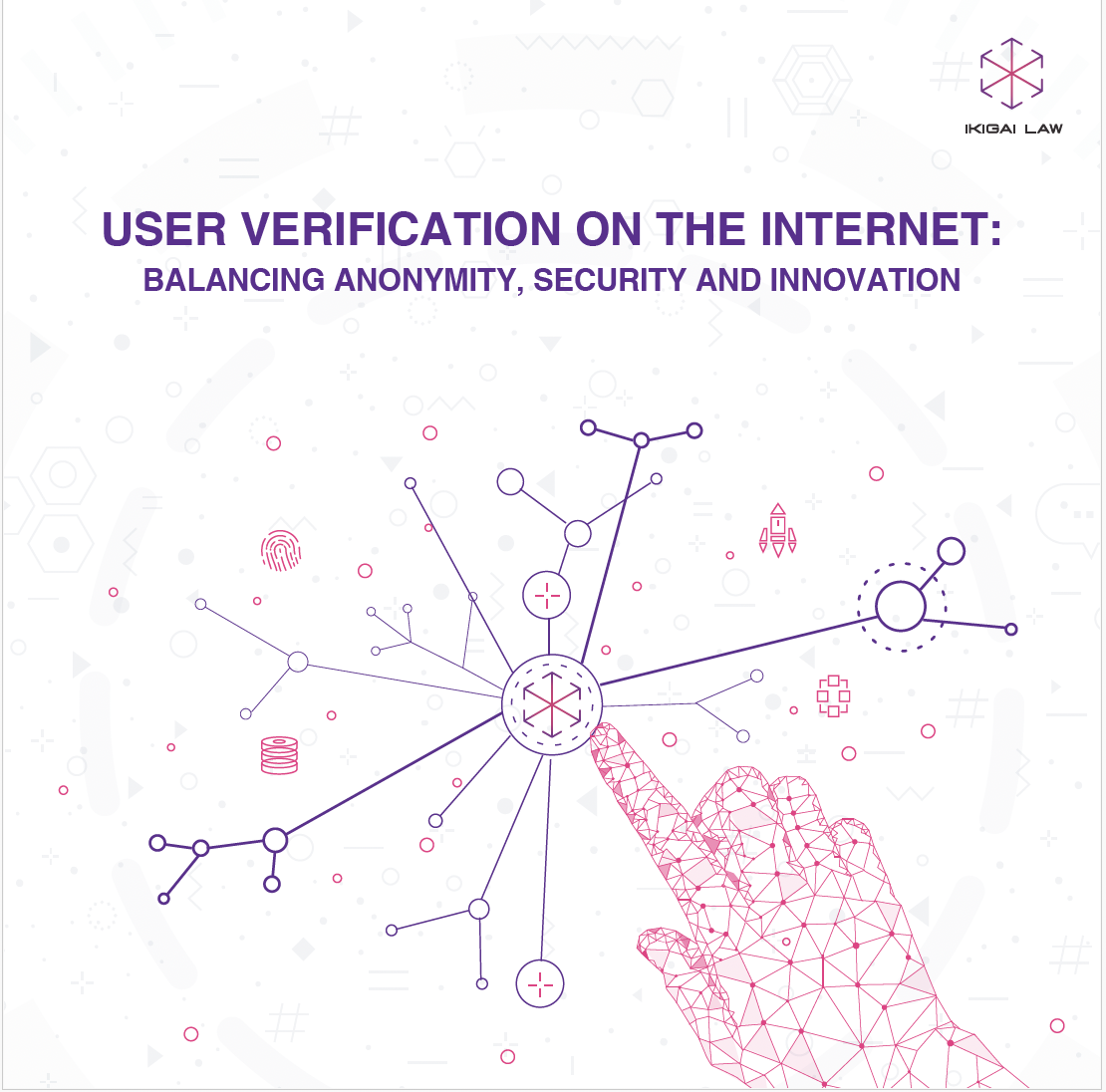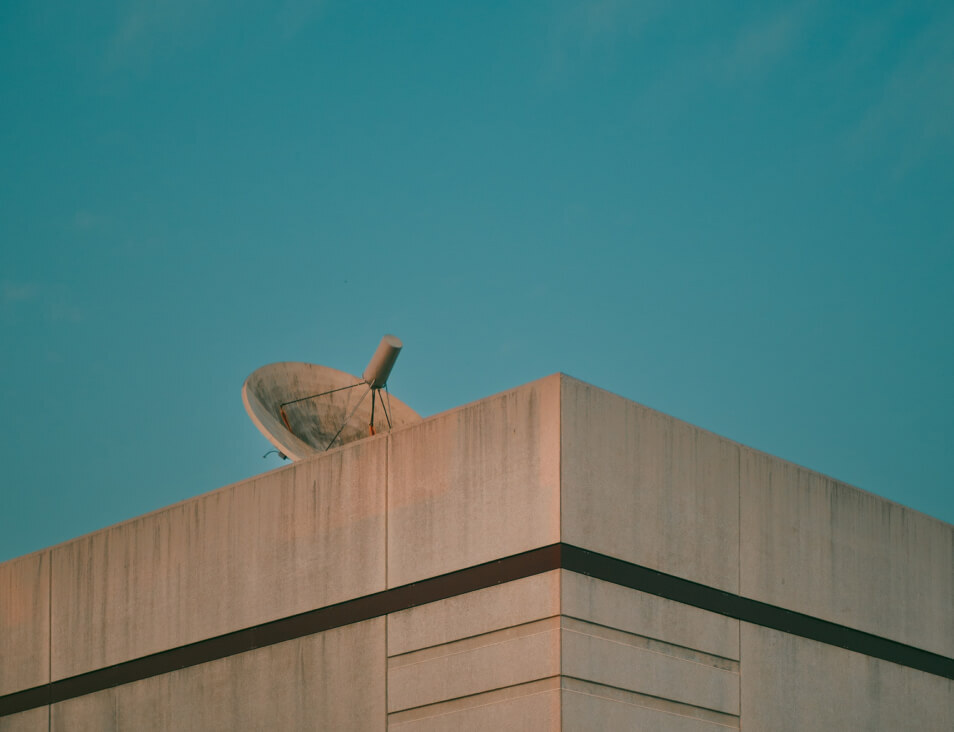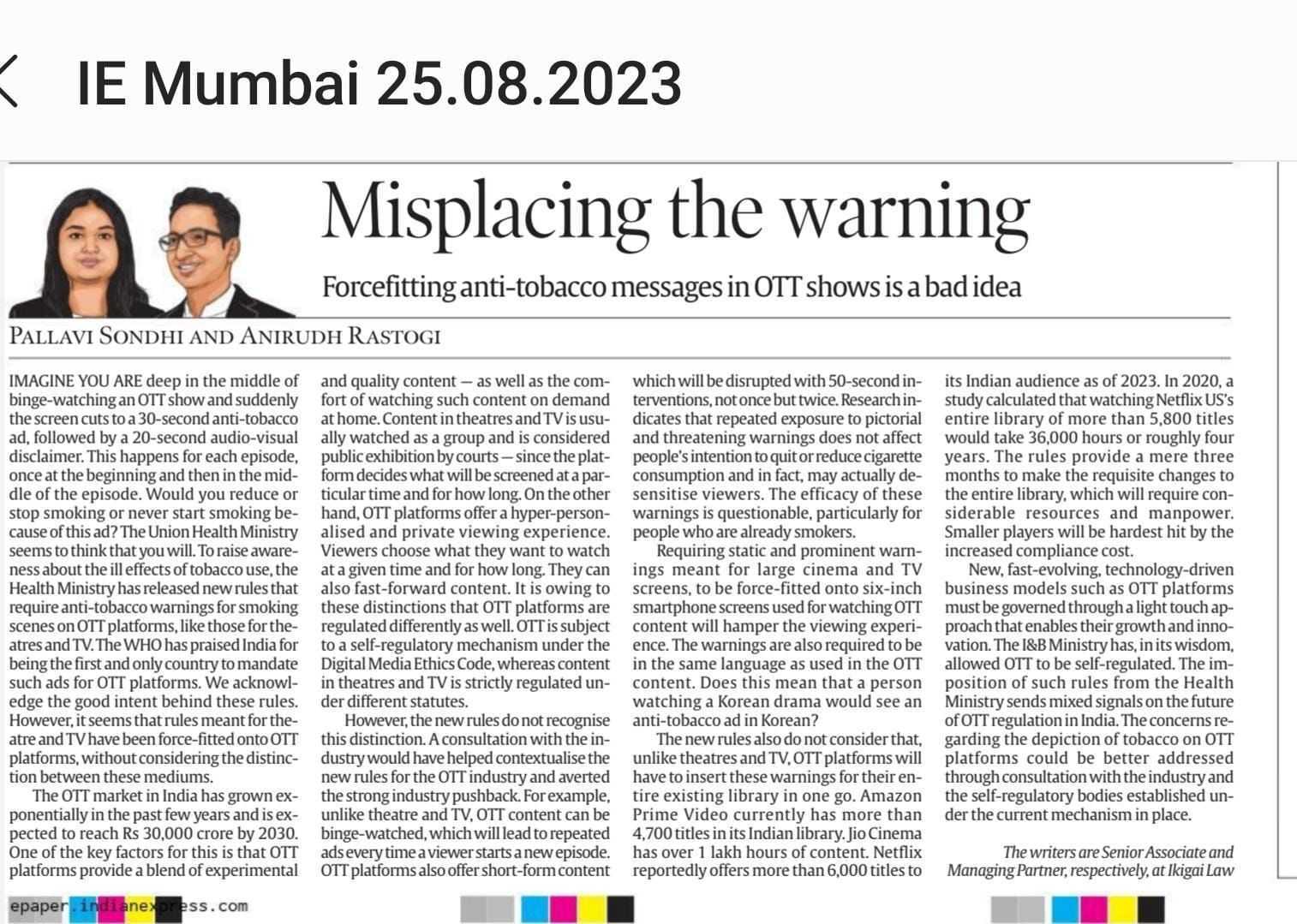This post provides an introduction to Internet Exchanges in India and examines the regulatory issues plaguing the sector. We also look at a recent regulatory dispute currently in the Delhi High Court and discuss its importance.
Background
The internet makes it easy for us to send a message from one corner of the world to another, but do you know how that happens? Internet Exchange Points (IXPs) are the physical infrastructure that are vital for the functioning of the internet. IXPs are where internet service providers (ISPs) meet up to exchange data with each other. They are a vital cog in the information superhighway and without them our internet would slow down to a crawl, bringing back memories of the dial-up era. However, the legal status of IXPs in India is rather ambiguous and ill-defined. This article looks at the legal issues plaguing IXPs in India and their implications.
But first, to understand IXPs, let us try understanding a bit about the internet.
How does the internet work?
Internet traffic is exchanged through independent networks that are called autonomous systems. These can be a single network or a collection of networks, as long as they have the same way of exchanging traffic, aka, routing policy. Each autonomous system is allocated a unique identification number called an autonomous system number by the Internet Assigned Numbers Authority (IANA)[1] through regional registries established globally. For this purpose, India comes under the realm of the Asia Pacific Network Information Center (APNIC)[2]. While every ISP is not required to possess an autonomous system number, it is a requirement to be able to peer with some internet exchanges.
How do networks exchange traffic on the internet?
Traffic on the internet is commonly exchanged by:
- Internet protocol (IP) transit;
- Peering through an IXP; and
- Private Interconnection (PNI).
In IP transit, a larger ISP or a third-party transit provider (like Tata Communications or AT&T) carries a smaller ISP’s traffic across its network to enable it to reach the rest of the internet. As a third-party carries the traffic, the ISP loses control of the traffic[3] and hence, it does not always flow on the cheapest route. For example, ISP B, a small ISP in India wants to give its customer access to Netflix and hence, ties up with ISP A for IP transit. ISP A may then route the traffic to Netflix’s peer in Singapore via an international gateway in Chennai, instead of using the shorter, efficient route to Netflix’s peer in Mumbai. This could be because ISP A may not have a presence in Mumbai or the route to Mumbai may be congested. In other words, in transit the local ISP is paying the transit provider to ‘fetch the content’ from another server. This server may not be the closest server and could also be located overseas.
An IXP is a facility that enables interconnection between two or more ISPs for the direct exchange of internet traffic. The exchange of traffic on an IXP, is called peering. Peering reduces operating costs, keeps local internet traffic local, increases speed and decreases latency. For this reason, many large technology companies like Google[4], Netflix[5], Apple[6], Facebook[7] etc. maintain dedicated peering policies to deliver their content.
The IXP acts as a hub where networks can access other for mutual benefit without needing a dedicated physical interconnection for each peer. Peering can either be paid or settlement-free. In settlement-free peering, ISPs exchange traffic without any form of compensation[8] while under paid peering, ISPs reciprocally provide access to each other’s customers, but with some form of compensation or settlement fee.[9] With both forms of peering, it’s usually common to pay a fixed port fee to the IXP.
Internet services can become significantly cheaper by increasing peered traffic as a proportion of total traffic[10]. This is because with peering, the ISP is acquiring the content through the content provider’s local peer, which is often free or very cheap compared to IP transit. In other words, the content ‘comes to the ISP’ instead of the ISP paying a transit provider to fetch it from elsewhere.
A PNI is used when two networks want to exchange traffic between themselves alone. For instance, ISPs in smaller countries may choose to interconnect domestic traffic among each other through PNIs if there is not enough internet exchange infrastructure in that country.
The National Internet Exchange of India
Until 2003, India was dependent on expensive international links to interconnect domestic traffic.[11] This meant that if a message was to be sent from ISP A to ISP B in India, that message would leave India through ISP A’s transit network, only to re-enter the country on ISP B’s transit network. This was because there were no domestic internet exchanges in India at that time. After accepting the recommendations[12] of the Telecom Regulatory Authority of India (TRAI) to set up a domestic internet exchange, the Government of India facilitated the setup of the National Internet Exchange of India (NIXI) as the first Internet Exchange in India in 2003.[13].
NIXI was envisaged as a central body to handle interconnection of domestic internet traffic between peering ISP members. NIXI is carrier neutral; it does not compete with member ISPs and works on a non-profit basis.[14] However, NIXI’s effort to interconnect domestic traffic has not been very successful. TRAI recognized in its ‘Consultation Paper on Improving the Effectiveness of National Internet Exchange of India (NIXI)’ (TRAI NIXI CP) that for a variety of technical reasons caused by NIXI’s policies, it was difficult for ISPs to work with NIXI[15].
For instance, many ISPs did not have the capability to segregate domestic and international traffic on their networks and hence could not solely route domestic traffic through NIXI without affecting their international traffic[16]. One of the solutions discussed by TRAI was to require ISPs to mandatorily route all of their internet traffic through NIXI. However, TRAI also recognized that if this happened, it would put excessive strain on the nascent infrastructure of NIXI and also grant NIXI a monopoly on routing internet traffic in India[17]. Another reason for NIXI’s possible lack of success could be its requirement for every ISP to possess an autonomous system number[18]. Unfortunately, the cost of maintaining an autonomous system number in India can be quite steep as APNIC’s annual fees for the smallest ISPs is 1180 Australian Dollars, which may be beyond the reach of some of the smaller ISPs.[19]
Despite the TRAI NIXI CP being released, there continues to be little clarity on the exact legal regime surrounding NIXI till date. In fact, in response to the same consultation paper, one of India’s largest ISPs, Tata Communications (then known as VSNL) commented that NIXI should be required to be licensed as an ISP as it enables the exchange of traffic between “two stations and distributing the traffic between the ISPs”.[20]
However, the list of ISP licenses issued by the government do not include NIXI as a licensed entity.[21] It appears that since NIXI was set up with the Government’s blessing, it may be operating as a de facto licensed entity despite holding no license of its own.
Neither the Department of Telecommunications (DoT) or the TRAI have made any reference to the law governing IXPs since 2011[22].
This has not stopped the proliferation of a large number of Internet Exchanges in India. One search at Peering Directory peeringdb.com for ‘Mumbai’ will show you multiple IXPs operating in Mumbai alone, such as Amsterdam Internet Exchange India (AMS-IX), Bharat IX, Extreme-IX and DE-CIX, in addition to NIXI[23].
The law for IXPs in India
In India, telecommunications services are licensed under the Indian Telegraph Act, 1855. The Telegraph Act governs the licensing and operation of ‘telegraphs’, which have been defined broadly enough to govern all form of telecommunications, including the internet.[24]
Under the Telegraph Act, read with the Government of India (Allocation of Business) Rules, 1961, the DoT exercises powers to license and regulate the telecommunications sector in India[25]. Through this power, the DoT issues various licenses for telecom services, usually through the Unified License, which covers the vast majority of telecom services offered in India.[26]
Unfortunately, India does not have a clear legal regime governing IXPs. None of the licenses offered by the DoT currently envisage an IXP service. The Unified License does not even use the term, ‘internet exchange’ anywhere. In fact, the DoT has even published a Right to Information request on its website which questioned if there was a dedicated licensing regime for IXPs in India[27]. However, the question appears to remain unanswered on its website and this legal ambiguity is now starting to affect the industry.
Extreme Infocom v. Union of India
The lack of a legal framework regarding IXPs recently affected one of India’s largest IXP operators, Extreme Infocom (EI) [28]which has become embroiled in a legal dispute with the DoT.
Before commencing its services in 2016, EI had reached out to the DoT to clarify the licensing regime for IXPs.[29] However, it received no reply from the DoT. EI then decided to commence services with the understanding that a license may not be required for IXPs in India. It approached Tata Communications (Tata) for certain services that were necessary for its operations, such as national dedicated ethernet, national private line, and international leased lines.[30]
In September 2018, EI received emails from Tata asking about the licensing framework applicable to the company. As EI had not received any reply from the DoT regarding licensing, it informed Tata that no licensing requirement existed and it had already requested DoT to clarify if it was subject to licensing requirements.[31]
Meanwhile, in March 2019, a complaint against EI was lodged with DoT. It was alleged that EI was carrying out illegal activities. EI claims that the DoT found no such illegality in its investigation.[32]
Thereafter, in May 2019, Tata informed EI that the DoT had clarified to them that IXPs are covered the Telegraph Act and hence, EI would require an appropriate license. Without this, the services being provided by Tata to EI would be disconnected.[33]
In response to this, in May 2019, EI wrote to the DoT again, asking it to clarify any license requirements. The DoT, in June 2019, told EI what it had told Tata.[34] Subsequently, the DoT also wrote to EI’s clients asking them to stop using EI‘s services because it was in breach of the Telegraph Act by operating without a license.
Eventually EI sued the Government of India (the DoT) in the Delhi High Court[35]. It sought to restrain the DoT from requiring EI to obtain a license to provide its services.
Arguments by the DoT and Extreme Infocom
The DoT considers IXPs to be a framework for ISPs to peer and exchange IP traffic with each other[36]. According to the DoT, when messages are switched from one licensed service provider to another, a license is necessary under Section 4 of the Telegraph Act (authorizes the Government of India to grant licenses and privileges to operate telegraphs). The DoT claims that the activities of an internet exchange i.e. handling traffic of other ISPs, are covered under the terms of the Unified License and thus IXPs would be required to obtain an ISP license in India.[37]
On the other hand, EI argues that the DoT’s definition of IXP is irrelevant because an IXP does not provide any ‘bandwidth’ and that it merely provides physical infrastructure and hardware ports on rent [38]. EI argues that the ambit of Section 4 of the Telegraph Act is so wide that all activities carried out by the Ministry of Electronics and Information Technology would also require a license. To support its argument that IXPs should be treated differently, EI relied on:
- The TRAI Report which recommended the setting up of a domestic Internet Exchange, without mentioning the need for a separate licensing regime under Section 4 of the Telegraph Act[39].
- TRAI’s Recommendations on “Telecommunications Infrastructure Policy” which acknowledged the lack of clarity on the legal framework applicable to IXPs and recommended that IXPs be brought within the ambit of a proposed ‘Class License’[40].
- The fact that NIXI continues to operate without a license under Section 4 of the Telegraph Act.
- The Government’s National Digital Communications Policy 2018 (“NDCP 2018”) which states the Government’s intention to “[E]volve enabling regulatory frameworks and incentives for promoting the establishment of International Data Centres, Content Delivery Networks and independent interconnect exchanges in India”[41] without specifying that licenses would be required for such exchanges.
- The TRAI’s absence of tariff orders for IXP services and in the absence of such Tariff Orders, EI would not be able to provide services[42].
EI requested the court to exclude IXPs from requiring an ISP license like the DoT wanted. While the matter is still pending in court, on July 23rd 2019, the Delhi High Court passed an order allowing EI to continue its business till the matter is finally determined.
ISP license conditions are not the best fit for IXPs
Given the Telegraph Act’s wide scope and jurisdiction, the DoT’s insistence on a license may have some merit in law. But is an ISP license for IXPs the right approach? IXPs offer a service that is unique and differentiated compared to ISPs, and thus, the two cannot be put in the same bucket.
Let us look at a few conditions of the Unified License as applicable to ISPs and assess the difficulty that IXPs could face if they are treated like ISPs.
- Infrastructure[43] – The Unified License requires ISPs to ‘provision their own arrangements for infrastructure and they shall be ‘solely responsible’ for ‘installation, networking, operation and commissioning of necessary infrastructure, equipment and systems’. However, when IXPs facilitate the interconnection of traffic between multiple ISPs, a lot of the networking configuration and peering may actually depend on the ISPs and their content partners instead of the IXP. For instance, Netflix maintains detailed peering policies for ISPs looking to connect with them at an IXP[44]. Therefore, it may not be possible for an IXP to be solely responsible for the networking and operation of the necessary infrastructure.
- Quality of Service[45] – In the context of IXPs, Quality of Service (QoS) is generally agreed in the form of a contract between the service provider and the service recipient. For instance, one of India’s largest internet exchanges DE-CIX India, publishes its service level agreements on its website[46]. However, the Unified License contains terms which could potentially supersede the terms of commercial contracts that the IXP may enter into with its clients. The Unified License suggests that the violation of QoS norms contractually agreed with other ISPs could be a violation of the license terms itself and thus could trigger penalties under the license. These could include cancellation of the license or financial penalties payable to the Government, which could be up to Rupees 10,000,000 (Ten Million) in case of ISPs[47]. The provision does not even consider setting off such penalties against remedial measures or compensation that an IXP may offer to its customers for such breach. Such provisions affect the risk calculation that IXPs make in designing their service agreements and further disincentivise IXPs from setting up shop in India.
- Requirement to accept all customers[48] – The Unified License contains provisions which require the ISP to provide its service in all regions where it has authorization[49]. If technical reasons make such provision difficult, the Licensee is required to “endeavour to make arrangement for providing connections/Service in such cases within a reasonable time.” In the context of an ISP or a cellular services provider this obligation could nudge the service providers to broaden the accessibility of their services. However, IXPs provide an enterprise service and they should be provided the commercial autonomy to select the recipient of their services. An IXP (through an ISP license) cannot be expected to provide internet services to prospective customers, when provision of internet services is not the IXPs core business.
- Billing[50] – Some international ISPs, tie up with their IXP partners to provide connectivity to India. (eg. AMS-IX and DE-CIX.). They do so by entering into re-sale agreements. Under these arrangements, IXPs aggregate and purchase access on behalf of their clients from partner IXPs around the world (including Indian IXPs). This is done for multiple reasons, such as convenience, lower costs, less paperwork and accessing end-to-end connectivity to other regions through a single point of contact and through a single bill[51]. Unfortunately, the current license terms appear to prohibit ISPs from appointing re-sellers of bandwidth[52]. Under the present license conditions customers abroad have to individually deal with invoices issued by Indian IXPs instead of being able to aggregate their connectivity requirements with a single IXP. While there are provisions in the Unified License that permit the appointment of ’franchisees, agents and distributors’[53], the Unified License is less clear about the exact roles these parties can play in the ultimate provision of the service.
- Lack of Tariff Orders – As described in the preceding section, ISPs are required to abide by Tariff Orders issued by the TRAI.[54] But the absence of a specific tariff order for IXP services, it makes it difficult for IXPs to comply with this requirement.
Conclusion
IXPs offer a critical but differentiated service to ISPs that enable the functioning of the internet. Therefore, it is crucial for policy makers to encourage the growth of IXPs in India. Treating IXPs as the equivalent of ISPs for regulatory purposes is detrimental to their growth. As the NDCP 2018 has recognized, policy makers need to create an enabling regulatory framework to facilitate independent interconnect exchanges in India. NIXI’s exact role and position in law must also be clarified. India has a unique geographical advantage, as it is located conveniently between the submarine cables that cross Europe and Asia. India’s impending data protection legislation and its expected data localization requirements is expected to drive further demand for local interconnectivity solutions. To truly take advantage of its geography and become an emerging data hub, India will have to engage with the industry to develop an enabling regulatory framework for IXPs.
This piece has been authored by Arvind Ravindranath, Consultant, Ikigai Law, with inputs and editorial assistance from Nehaa Chaudhari, Partner.
For more on the topic, please get in touch at contact@ikigailaw.com
[3] https://www.thousandeyes.com/learning/techtorials/isp-peering
[4] https://peering.google.com/#/options/google-global-cache
[5] https://openconnect.netflix.com/en/peering/
[7] https://www.facebook.com/peering
[8] Available at, https://arxiv.org/pdf/1801.00095.pdf
[9] Available at, https://drpeering.net/white-papers/Ecosystems/Internet-Paid-Peering.html
[10] https://cis-india.org/internet-governance/blog/regulatory-perspectives-on-net-neutrality
[11] https://trai.gov.in/sites/default/files/9SEP1052012.pdf
[12] Report of Task Force on Growth of Internet in the Country, August 2002, Available at: https://trai.gov.in/sites/default/files/9SEP1052012.pdf
[13] https://nixi.in/en/about-us
[14] TRAI Consultation Paper, available at, https://www.trai.gov.in/sites/default/files/VSNL_01112006_0.pdf
[15] Refer to Chapter 4 of Consultation Paper on Improvement in the Effectiveness of National Internet Exchange of India (NIXI) at https://www.trai.gov.in/sites/default/files/Consultationpaper1nov06pdf.pdf
[16] Response by VSNL to TRAI’S Consultation Paper Available at: https://www.trai.gov.in/sites/default/files/VSNL_01112006_0.pdf
[17] Ibid
[18] https://nixi.in/en/faq#q7
[19] https://www.apnic.net/get-ip/apnic-membership/how-much-does-it-cost/#:~:text=The%20minimum%20annual%20fee%20for,of%20a%20Member’s%20annual%20fee.
[20] TRAI Consultation Paper (pg.11, para 5.4.2), available at, https://www.trai.gov.in/sites/default/files/VSNL_01112006_0.pdf
[21] https://saralsanchar.gov.in/documents/List_of_ISP_Licenses_as_on_31.7.2018.pdf and https://saralsanchar.gov.in/documents/List_of_ISP-UL.pdf
[22] In 2011, TRAI made a recommendation https://www.trai.gov.in/sites/default/files/Rec_Infrastructurel.pdf
[23] https://www.peeringdb.com/search?q=mumbai
[24] Section 3 (1AA) defines ‘telegraph’ to mean any appliance, instrument, material or apparatus used or capable of use for transmission or reception of signs, signals, writing, images and sounds or intelligence of any nature by wire, visual or other electro-magnetic emissions, Radio waves or Hertzian waves, galvanic, electric or magnetic means
[25] https://cabsec.gov.in/writereaddata/allocationbusinessrule/completeaobrules/english/1_Upload_915.pdf
[26] https://dot.gov.in/unified-licnse
[27] https://dot.gov.in/rtis/dotelr201850466
[28] Extreme Infocom Pvt. Ltd. v. Union of India, W.P. (C) No. 7804 of 2019
[29] Extreme Infocom Pvt. Ltd. v. Union of India, W.P. (C) No. 7804 of 2019 (pg. 21)
[30] Extreme Infocom Pvt. Ltd. v. Union of India, W.P. (C) No. 7804 of 2019 (pg. 22)
[31] Extreme Infocom Pvt. Ltd. v. Union of India, W.P. (C) No. 7804 of 2019 (pg. 22)
[32] Extreme Infocom Pvt. Ltd. v. Union of India, W.P. (C) No. 7804 of 2019 (pg. 23)
[33] Extreme Infocom Pvt. Ltd. v. Union of India, W.P. (C) No. 7804 of 2019 (pg. 23)
[34] Extreme Infocom Pvt. Ltd. v. Union of India, W.P. (C) No. 7804 of 2019 (pg. 38) at Annexure P1
[35] Extreme Infocom v. Union of India WP (C) No. 7804 of 2019 in Delhi High Court.
[36] Letter from DoT to EI, Extreme Infocom Pvt. Ltd. v. Union of India, W.P. (C) No. 7804 of 2019 at Annex P-1 (pg. 38)
[37] The DoT cited Clause 4.1 OF Chapter IX (Internet Services) of the Unified License, which states: “The Licensee may establish direct interconnectivity with the network of other Internet Service Providers/Unified Licensee having authorisation of Internet Service. The Licensee may obtain leased bandwidth from any other Licensee authorised to provide such bandwidth on leas.
[38] Available at, https://dot.gov.in/sites/default/files/Unified%20Licence_0.pdf
[39] Report of Task Force on Growth of Internet in the Country, August 2002, Available at: https://trai.gov.in/sites/default/files/9SEP1052012.pdf
[40] Para 2.25 of TRAI’s Recommendations on ‘Telecommunications Infrastructure Policy’ Available at: https://trai.gov.in/sites/default/files/Rec_Infrastructurel.pdf
[41] Refer to Para 2.2 (f) (i) of the NDCP 2018 available here: https://dot.gov.in/sites/default/files/2018_10_29%20NDCP%202018_0.pdf
[42] Clause 17 of the Unified License states that “ The Licensee will charge the tariffs for the Service as per the Tariff orders / regulations / directions/decisions issued by TRAI from time to time. The Licensee shall also fulfill requirements regarding publication of tariffs, notifications and provision of information as directed by TRAI through its orders / regulations / directions issued from time to time as per the provisions of TRAI Act, 1997 as amended from time to time.”
[43] Clause 2.4 of the Unified License states “Licensee shall make its own arrangements for all infrastructure involved in providing the service and shall be solely responsible for the installation, networking, operation and commissioning of necessary infrastructure, equipment and systems, treatment of subscriber complaints, issue of bills to its subscribers, collection of revenue, attending to claims and damages arising out of its operations etc. However, the Licensee may share the infrastructure as permitted under the scope of respective service authorization in PART-II of the Schedule to the License Agreement or as per the directions/instructions issued by the Licensor from time to time.”
[44] https://openconnect.zendesk.com/hc/en-us/articles/360035533071#routing-and-content-steering-via-bgp
[45] Clause 28.1 of the Unified License states that: The Licensee shall operate and maintain the licensed Network conforming to Quality of Service standards to be mutually agreed with other TSPs in respect of Network- Network Interface subject to such other directions as Licensor or TRAI may give from time to time. Failure on the part of Licensee to adhere to the network to network interface standards of TEC is liable to be treated as breach of LICENSE terms and conditions. For the purpose of providing the Service, the Licensee shall install his own equipment so as to be compatible with other telecom service providers’ equipment to which the Licensee’s Applicable Systems are to be interconnected. The Licensee shall be solely responsible for attending to any claims and damages arising out of his operations.
Clause 29.1 of the Unified License states that: The Licensee shall ensure the Quality of Service (QoS) as may be prescribed by the Licensor or TRAI. The Licensee shall operate and maintain the licensed Network conforming to Quality of Service standards subject to such other directions as Licensor / TRAI may give from time to time. The Licensee shall adhere to such QoS standard and provide timely information as required therein. Failure on part of Licensee to adhere to the Quality of Service stipulations by TRAI/Licensor is liable to be treated as breach of terms and conditions of License.
The LICENSEE shall provide periodic information on compliance of QoS standards to TRAI/Licensor as per schedule notified.
[46] https://www.de-cix.in/sla
[47] Schedule VI of the Unified License sets out that the maximum penalty applicable for an ISP at a time could be up to Rupees 10,000,000 (Rupees Ten Million) which approximate to USD 135,000.
[48] Clause 30.2 of the Unified License: The LICENSEE shall widely publicize provision of service and shall not refuse registration of demand in the service areas in which the Licensee has commenced services. In case the provision of telephone connection or the requested telecom service to an applicant is not feasible for technical or other reasons beyond the control of Licensee, then the LICENSEE shall endeavour to make arrangement for providing connections/Service in such cases within a reasonable time.
[49] The Unified License allows ISPs to seek licenses as Category A (National), Category B (State) and Category C (District).
[50] Clause 30.4 of the Unified License It shall be the responsibility of the LICENSEE to issue or cause to be issued bills to its subscribers for use of the service. The LICENSEE shall maintain such records so as to produce itemized billing information. The billing system of the LICENSEE shall be able to generate the billing information, in adequate details, to ensure satisfaction of the subscribers about the genuineness of the bill. The directions of TRAI, from time to time, in this regard shall apply.
30.5 The LICENSEE shall offer a regular itemised billing to its subscribers wherever applicable. In every case the LICENSEE shall be responsible to its subscribers and shall ensure fulfilment of the obligations in this regard. The LICENSEE shall also maintain necessary records for the billing cycles as specified by the Licensor or TRAI from time to time.
[51] https://www.de-cix.net/en/access/how-to-connect/connect-via-reseller
[52] Clause 30.4 of the Unified License states” It shall be the responsibility of the LICENSEE to issue or cause to be issued bills to its subscribers for use of the service. The LICENSEE shall maintain such records so as to produce itemized billing information. The billing system of the LICENSEE shall be able to generate the billing information, in adequate details, to ensure satisfaction of the subscribers about the genuineness of the bill. The directions of TRAI, from time to time, in this regard shall apply.”
[53] Clause 6.1 of the Unified License
[54] Clause 7.1 of the Unified License states that “The Licensee will charge the tariffs for the Service as per the Tariff orders / regulations / directions/decisions issued by TRAI from time to time. The Licensee shall also fulfill requirements regarding publication of tariffs, notifications and provision of information as directed by TRAI through its orders / regulations / directions issued from time to time as per the provisions of TRAI Act, 1997 as amended from time to time.”










